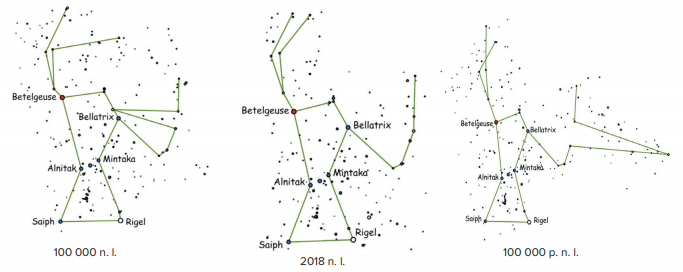Practical Exercise 8: MODEL OF ORION CONSTELLATION
Three-dimensional models of the Solar system are quite frequent and approved method of visualizing the distances and arrangement of individual objects and can be found in many places (see e.g. Richterek and Látal, 2013).
Objective of Practical Exercise:
The objective of practical exercise is to create a three-dimensional model of a constellation where we can demonstrate that the stars observed close to one another in the sky and belonging to one constellation, can in reality lie in various distances from us. Moreover, we can look at the constellation from different sides and show that the arrangement seen in the sky is only a plane of projection from one particular direction.

Fig. 9: Installation in front of a high school in Great Britain (taken from Brown, 2013). The stones represent a „new outline“ of constellation from the above.
Models can be created in various scales, on the schoolroom desk or outside the school within the Project Day (see Fig.9; in such case we would need the area at least 3 m × 15 m). Students should be familiar with the notion of a scale (it is possible to revise). On the ground of a similar principle, we can construct a model of another constellation (e.g. at choice of students), the Solar System (e.g. at a scale of 1 au = 10 cm, Neptune would be then located in the distance of 3 cm from the Earth) or our Galaxy (e.g. at a scale of 100 000 ly = 1 m, Solar System would be then located 30 cm from the centre of the disc which would be 15 cm thick in the central part). We remind that when working with various sources, we can obtain different data about distances of stars, however the order (tens, hundreds, thousands of ly) is more important that the value of 3 or more valid digits.
It is possible to show on the model that the light from the stars, that we observe now, has been emitted in different times; according to the scale proposed in the activity sheet it will pass 1 cm in the model in 10 years. The time of light emission, that we observe now, can be matched with the historical events 450, 650 or 1300 years ago.
The stars of Orion can also serve to demonstrate various stages of „life“ and development of stars. Their age mostly does not reach the geological age of the Earth – 4.5 billion of years. The youngest Orion stars are situated in the emission nebula M42 and their age is estimated to 10 000 – 300 000 years (they have been formed in the times when the Earth was inhabited by Neanderthal people, or perhaps even hominids of Homo sapiens species). The age of stars from Orion belt, Mintaka and Alnilam varies in the range of 3 – 6 million years and matches the time when Earth was inhabited by hominids of Australopithecus species. The age of red giant Betelgeuse varies around 10 millions of years and in the time of its creation, there were no hominids on Earth and neither the grassy meadows and savannahs as we know them nowadays.
The additional activities can be done individually by students; we can solve them together with the class or give them as homework. With the help of computer softwares, we can easily observe the change of mutual position of stars in time (Fig.10) and realise that even though from the point of view of lifetime of several human generation they seem to be fixed stars, in the longer period of time, their mutual position and distance changes (even a „a little bit“). Various computer softwares can draw lines joining the stars in the constellation with particular differences.

n.l. – AD (Anno Domini), př.n.l. – BC (before Christ)
Fig. 10: Constellation of Orion throughout the time (generated by SkyChart/Cartes du Ciel software, adapted)


